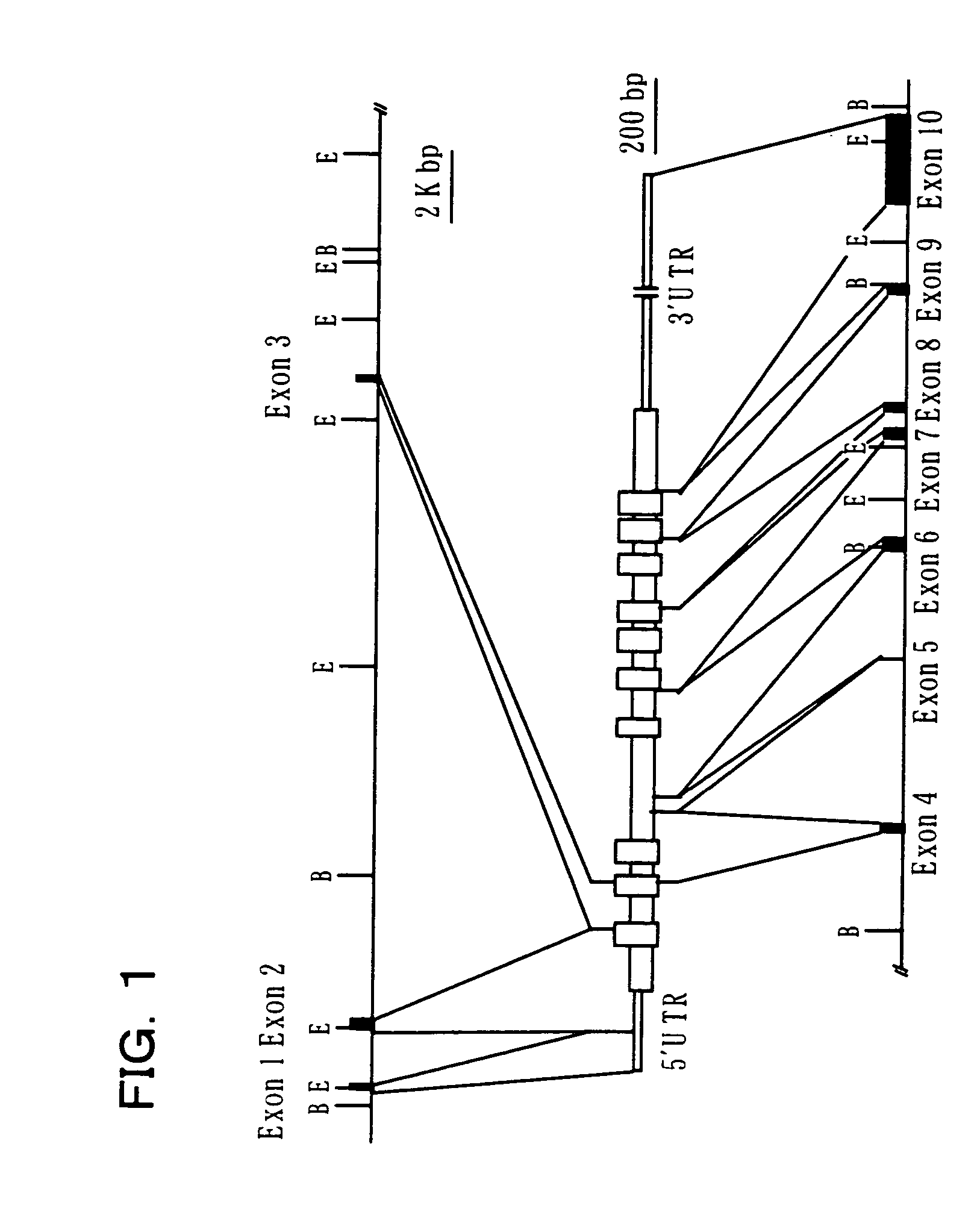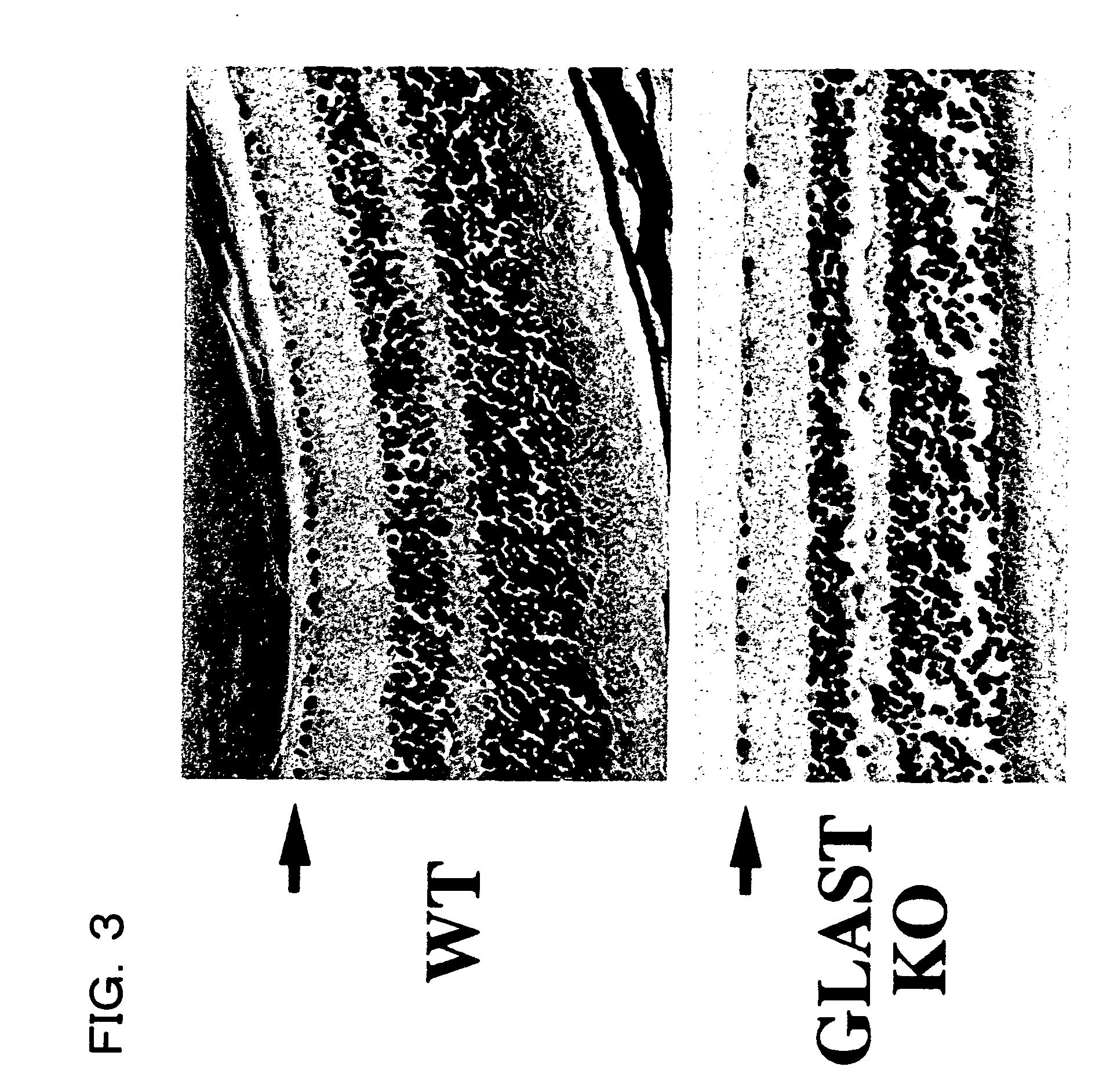Mouse with deficiency of glutamate transporter glast function
a glutamate transporter and mouse technology, applied in the field of mouse glast knockout mouse, can solve the problems of affecting the visual performance of the mouse, affecting the normal function of the mouse, so as to reduce the number of cells in the retinal ganglions.
- Summary
- Abstract
- Description
- Claims
- Application Information
AI Technical Summary
Benefits of technology
Problems solved by technology
Method used
Image
Examples
example 1
Production of Mouse Deficient in the Function of GLAST (GluT-1) Gene
(1) Preparation of DNA for Homologous Recombination in Mouse GLAST (GluT-1) Gene DNA
[0123] Genomic DNA extracted from the liver of a 129SV mouse was partially digested with restriction enzyme Sau3AI. For the resulting genomic library lambda FIXII, hybridization was carried out using as a probe a partial sequence of cDNA for mouse GLAST (GluT-1) gene. Colonies of 1×106 were screened to give 26 positive clones. After the clones were incompletely digested with restriction enzymes EcoRV and XhoI, the full length genomic DNA of 9 kbp containing exons 6 to 8 was subcloned thereto (FIG. 2, upper column). Next, in order to disrupt the GLAST (GluT-1) gene, a 1.5 kbp region following the BamHI site in exon 6 was made defective, and the neomycin-resistant gene was inserted therein and a diphtheria toxin A fragment gene was further inserted into the downstream of exon 8 (FIG. 2, middle column). The homologous region with the...
example 2
Measurement of Intraocular Pressure
[0140] At the age of 1 year old, the intraocular pressure was measured in the homozygous GLAST knockout mice obtained in EXAMPLE 1 and wild type normal mice. After four mice per group were anesthetized, the intraocular pressure was measured with an electronic tonometer. The results are shown below.
[0141] Wild-type normal mice: 19±4 mmHg
[0142] Homozygous knockout mice: 15±3 mmHg (mean±standard deviation)
[0143] From the results, it was confirmed that the intraocular pressure of homozygous GLAST knockout mice was within the normal pressure.
example 3
Measurement of the Number of Cells in the Retinal Ganglions
[0144] In the homozygous GLAST knockout mice and heterozygous GLAST knockout mice obtained in EXAMPLE 1 and wild-type normal mice, the number of cells in the retinal ganglions was measured in each mouse by the hematoxylin / eosin staining of retinal sections and the retrograde labeling of retinal nerve cells by Fluoro-Gold or DiI.
Observation by Section Staining:
[0145] 1) Test mice were anesthetized for sedation with a 1:1 mixture of ketamine (10 mg / ml) / medetomidine (1 mg / ml) (0.15-0.2 ml / mouse) and perfused in 4% paraformaldehyde to fix.
[0146] 2) Eye globes were enucleated and fixed at 4° C. in the same solution for further 2 hours.
[0147] 3) After the eye globes were embedded in paraffin, sections, e.g., 7 μm thick sections were prepared.
[0148] 4) The sections were stained with hematoxylin / eosin and the nerve cells in the retinal ganglion region were observed under microscope. The microscopic images are shown in FIG. 3....
PUM
| Property | Measurement | Unit |
|---|---|---|
| intraocular pressure | aaaaa | aaaaa |
| intraocular pressure | aaaaa | aaaaa |
| intraocular pressure | aaaaa | aaaaa |
Abstract
Description
Claims
Application Information
 Login to View More
Login to View More - R&D
- Intellectual Property
- Life Sciences
- Materials
- Tech Scout
- Unparalleled Data Quality
- Higher Quality Content
- 60% Fewer Hallucinations
Browse by: Latest US Patents, China's latest patents, Technical Efficacy Thesaurus, Application Domain, Technology Topic, Popular Technical Reports.
© 2025 PatSnap. All rights reserved.Legal|Privacy policy|Modern Slavery Act Transparency Statement|Sitemap|About US| Contact US: help@patsnap.com



